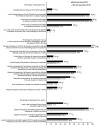Ebola risk perception in Germany, 2014
- PMID: 25989020
- PMCID: PMC4451905
- DOI: 10.3201/eid2106.150013
Ebola risk perception in Germany, 2014
Abstract
Ebola virus disease (EVD) outbreaks have occurred during the past 5 decades, but none has affected European countries like the 2014 epidemic in West Africa. We used an online questionnaire to investigate risk perceptions in Germany during this epidemic peak. Our questionnaire covered risk perceptions, knowledge about transmission routes, media use, reactions to the outbreak, attitudes toward measures to prevent the spread of EVD and vaccination against EVD, and willingness to volunteer for aid missions. Of 974 participants, 29% indicated that they worried about EVD, 4% correctly stated virus transmission routes, and 75% incorrectly rated airborne transmission and transmission by asymptomatic patients as possible. Many indicated that if a patient were flown to Germany for treatment in a nearby hospital, they would adapt preventive behavior. Although most participants were not worried about EVD at the current stage of the epidemic, misperceptions regarding transmission were common and could trigger inappropriate behavior changes.
Keywords: EVD; Ebola; Ebola virus; Ebola virus disease; Germany; behavior; hemorrhagic fever; perception; risk; transmission; viruses.
Figures

References
MeSH terms
LinkOut - more resources
Full Text Sources
Other Literature Sources
Medical
Miscellaneous

